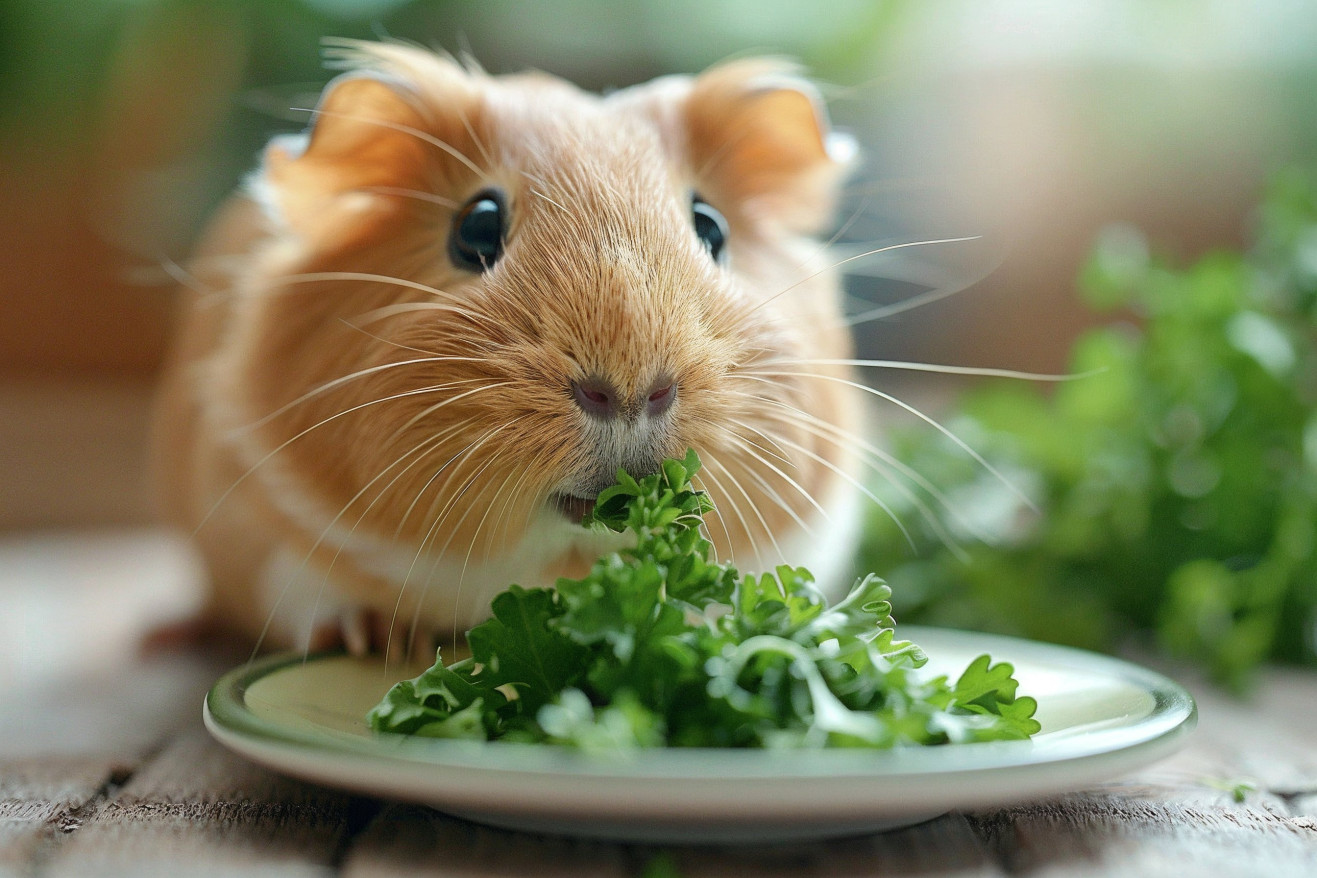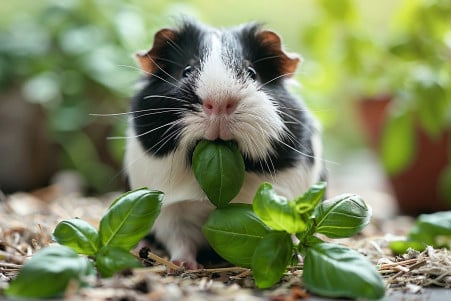Can Guinea Pigs Eat Parsley? Benefits and Precautions
29 March 2024 • Updated 29 March 2024

Parsley can be a good way to mix up your guinea pig's diet, but it's important to know the nutritional value and potential downsides of feeding it to your pet. Yes, guinea pigs can eat parsley, but it should be given to them in moderation as part of a well-rounded diet. Parsley is a great source of vitamin C and low in calories, but it also has oxalates that can cause urinary and kidney problems if it's over-consumed.
We'll go over the most recent veterinary advice and recommendations to help you figure out how much parsley you should feed your guinea pig, the best ways to prepare it, and whether or not it's a good idea to give it to them in the first place. This way, you can decide whether or not you want to give your pet this leafy green and know that you're looking out for their best interests.
Can guinea pigs eat parsley?
Nutritional Benefits of Parsley for Guinea Pigs
Parsley is an especially good source of vitamin C, with a whopping 133.3 mg per 100g, which is almost three times the amount found in an orange. This makes it a particularly good option for guinea pigs, who can't make their own vitamin C and need to get it from the food they eat to support their skin, joint, and immune health.
In addition to its vitamin C content, parsley is also a good source of vitamin K, which is important for blood clotting and wound healing. It also has antioxidants that can help protect the body's cells from damage by free radicals. Plus, it's low in calories and sugar, so it's a healthy choice for guinea pigs.
On the other hand, parsley is high in calcium and oxalates. While calcium is an important nutrient, it can lead to bladder stones if it's consumed in high amounts, especially when it's combined with the oxalates found in parsley. As a result, while it's healthy overall, parsley should be fed in moderation to guinea pigs to avoid potential urinary problems.
By learning about the nutritional benefits and potential downsides of parsley, pet parents can decide whether to feed this tasty herb to their pets as part of a well-rounded diet.
How Much Parsley Can You Feed Your Guinea Pig?
The Guinea Pig Forum recommends feeding parsley to guinea pigs no more than twice a week. The forum also suggests a portion size of 5-10 sprigs per serving. This is because parsley contains a lot of calcium, which can lead to urinary and kidney problems if consumed in large quantities.
It’s also important to introduce parsley slowly and watch for any adverse reactions. GuineaPigCages.com recommends starting with a small amount and watching for any signs of tummy upset, such as diarrhea or a loss of appetite.
To make sure that your guinea pig gets a well-rounded diet, it’s best to rotate the vegetables and leafy greens that you feed them. Hepper explains that a healthy guinea pig diet includes hay, a small portion of pellets, and a variety of fresh fruits and vegetables, including parsley in moderation.
How to Prepare and Introduce Parsley to Guinea Pigs
When it comes to feeding parsley to your guinea pigs, it's important to know how to prepare the herb to ensure that it's safe and healthy for them to eat. While the Guinea Pig Forum says that many guinea pigs like parsley, it's still important to take the right steps to prepare it.
To start, make sure that you wash and rinse the parsley thoroughly to remove any pesticides or dirt. Then, make sure that you're feeding your guinea pig both the leaves and stems, as wikiHow Pet says that both parts of the herb are safe and healthy for guinea pigs to eat.
When you first introduce parsley, make sure that you're giving your guinea pig small amounts and watching to see how they react. GuineaPigCages.com suggests that you increase the amount that you give them slowly to see how much they can handle. This will help you avoid any potential digestive issues.
Finally, make sure that you're removing any parsley that your guinea pig hasn't eaten within a few hours of feeding them. Letting food sit in their cage can cause health issues, so it's important to keep their environment clean. If you follow these preparation and introduction tips, you should be able to add this healthy herb to your guinea pig's diet without any issues.
Symptoms of Digestive Problems and What to Do
Symptoms of digestive problems in guinea pigs, like diarrhea, loss of appetite, or depression, should be taken very seriously. According to the Merck Veterinary Manual, these symptoms can be caused by infections, dietary issues, or other health problems.
If digestive issues develop after introducing parsley, it’s important to remove the herb and any other potential irritants from the guinea pig’s diet. As ExoticDirect notes, pain relief, fluids, and medications that promote gut motility may be needed, and the guinea pig’s diet should be limited to fresh leafy greens and Timothy hay.
It’s important to get veterinary care as soon as possible, as wikiHow Pet warns that guinea pigs can become dehydrated and their symptoms can become severe if they aren’t treated. It may also be helpful to include gut-healthy herbs like chamomile to help the guinea pig recover.
By keeping a close eye on your guinea pig’s diet and behavior and responding quickly to any signs of digestive problems, you can help ensure that your guinea pig stays healthy when you introduce new foods like parsley.
Parsley as Part of a Healthy Guinea Pig Diet
Guinea pigs need a diet that is high in fiber, with hay and fresh vegetables making up the bulk of what they eat. The UK Pet Food organization explains that guinea pigs need food that is moderately high in fiber, so it is important to make sure that they have access to fresh hay in addition to their regular food.
Parsley should be considered a supplement, not a main part of their diet. The Winter Park Veterinary Hospital says that 75% of a guinea pig's diet should be hay, with the other 25% coming from a mix of fresh vegetables and greens. To make sure that they get all of the nutrients that they need, it is important to rotate parsley with other safe greens, herbs, and vegetables.
LafeberVet points out that two of the most important nutrients for guinea pigs are calcium and vitamin C. While parsley is a good source of vitamin C, guinea pigs can't make their own vitamin C, so they need to get it from their diet. That's why it is important to make sure that they eat a variety of foods that are high in vitamin C, including parsley.
As long as you make sure that your guinea pig's diet includes plenty of fiber, fresh vegetables, and the nutrients that they need, including vitamin C, parsley can be part of a healthy diet that supports their overall health.
Conclusion: Adding Parsley to Your Guinea Pig's Diet
Parsley can be a healthy and nutritious addition to your guinea pig's diet if it's given in moderation. It's a good source of vitamins and antioxidants, but it's important to make sure your guinea pig is also getting other vegetables and hay. However, because it's high in calcium and oxalates, it can lead to urinary and kidney problems if it's overconsumed.
Penthouse Piggies says that parsley is a good source of vitamins and minerals that can help guinea pigs in small amounts. GuineaPiggles explains that parsley is a nutritional powerhouse, especially when it comes to vitamin C, which is essential for guinea pigs. On the other hand, Hepper warns that parsley should be given in moderation because of its high levels of calcium and oxalates.
If you want to give your guinea pig parsley, make sure you watch how much and how often you give it to them. If you notice any digestive or other issues after giving your guinea pig parsley, make sure to talk to your vet.
By learning about the benefits and drawbacks of parsley, you can make sure that you're giving your pet a well-rounded and healthy diet that includes this nutritious herb.


